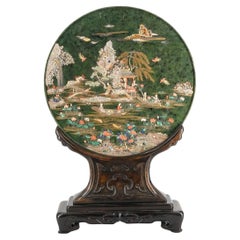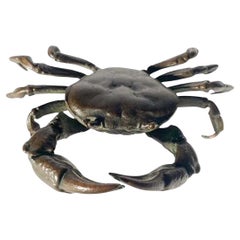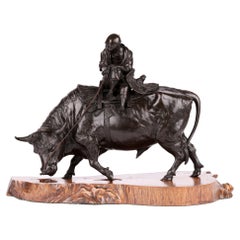YM Antiques Inc Sculptures and Carvings
to
1
1
1
1
1
1
1
1
1
1
1
1
Meiji Japanese Tsuda Family Embellished Jade Table Screen on Stand
Located in New York, US
Our large, antique circular jade exhibition screen from the Tsuda family is decorated with abalone shell, malachite, coral, lapis lazuli, pearl, and other hardstones. Depicted is a lakeside with figures in boats, colorful blooming flowers in the foreground, figures, pagoda and bridge and a rocky outcropping in the distance.
The legendary Tsuda family in Kyoto is revered around the world for their embellished jade carvings, particularly snuff bottles. Works by Tsuda Sokan and his son Tsuda Fukuya, regularly appear at auction and can be found in prestigious collections worldwide. Recommended literature: Moss, Graham, Tsang, A Treasury of Chinese Snuff Bottles, The Mary and George Bloch...
Category
Early 20th Century Japanese Meiji Sculptures and Carvings
Materials
Jade
Related Items
Signed Japanese Meiji Period Bronze Crab (E) Okimono
Located in Chapel Hill, NC
Signed Japanese okimono of a realistically modeled crab raised up on its toes and with claws raised. One of 5 designated by (E) in the title.
Category
Antique Late 19th Century Japanese Meiji Sculptures and Carvings
Materials
Bronze
Genryusai Seiya Japanese Meiji Man & Water Buffalo Sculpture on Stand
Located in Bishop's Stortford, Hertfordshire
An exceptional Japanese Meiji bronze sculpture of a man and water buffalo on a natural polished oak stand by renowned Japanese master craftsman Genryusai Seiya and dating from around 1880/90. The large bronze depicts an elderly man holding a pipe and tobacco pouch...
Category
Antique 1880s Japanese Anglo-Japanese Sculptures and Carvings
Materials
Bronze
$12,728 Sale Price
44% Off
H 13.78 in W 17.33 in D 5.52 in
Large Japanese Meiji Period Bronze Crab (C) Okimono
Located in Chapel Hill, NC
Realistically modeled Japanese okimono of a crab raised on its toes. I of 5 designated by the (C) in the title.
Category
Antique Late 19th Century Japanese Meiji Sculptures and Carvings
Materials
Bronze
Japan Early Ikebana Planter Garden Cart with Children, Meiji Period
Located in South Burlington, VT
A rare 19th century hard to find Japanese Usubata Flower Planter Cart "Norimono",
Late Meiji Period.
Japan, this handsome quality old style "garden cart" ikebana planter is an exceptionally rare find and an authentic old work of Japanese art.
Brilliantly designed and a handsome plant presentation with removable ikebana vase inserted into an openwork wicker basket set on a wheeled cart...
Category
Antique Late 19th Century Japanese Meiji Lanterns
Materials
Iron
$180 Sale Price
69% Off
H 10 in W 11 in D 8 in
Antique Japanese Root Stand
Located in Hudson, NY
Antique Japanese root stand. Meiji period (1868-1912) carving from a single piece of fruitwood in a natural root design. Originally made for presen...
Category
Antique Late 19th Century Japanese Meiji Sculptures and Carvings
Materials
Fruitwood
JAPAN 1890 Meiji Sculptural Polychromate Netsuke Of a Yamabushi
Located in Miami, FL
Japanese Meiji period netsuke. of a Yamabushi.
This is an exceedingly beautiful and intricate carved netsuke, created during the imperial Japan in the Meiji period, back in he 1890....
Category
Antique 1890s Japanese Meiji Sculptures and Carvings
Materials
Bone
$1,048 Sale Price
25% Off
H 2.01 in W 0.91 in D 0.95 in
Japanese Antique Pair Jade Green Mandarin Duck Screen Holders
Located in South Burlington, VT
A handsome pair of Japanese hand cast Mandarin Duck screen holders with highly detailed plumage possessing a lovely original jade green finish , early Taisho period, early 20th cen...
Category
Early 20th Century Japanese Meiji Paintings and Screens
Materials
Iron
Finely Carved Japanese Okimono on Stand
Located in Atlanta, GA
An antique Okimono (Japanese means artsy display ornament object) displayed on a small custom wood stand from Meiji Period circa early 2oth century. T...
Category
Early 20th Century Japanese Japonisme Sculptures and Carvings
Materials
Wood
Japanese Bronze & Crystal Okimono, 3 Crystal Spheres Riding Bronze Waves, Meiji
Located in Chapel Hill, NC
Japanese Meiji period bronze and crystal sculpture (okimono) of stylized waves supporting three crystal balls of varying size. Signed on underside.
Category
20th Century Japanese Meiji Sculptures and Carvings
Materials
Crystal, Bronze
$2,450
H 6.25 in W 10 in D 2.5 in
Pair of Japanese Gilt Bronze Komainu by Ishikawa Komei, Meiji Period
Located in Austin, TX
A striking pair of Japanese gilt bronze komainu by the renowned Japanese sculptor, Ishikawa Komei (1852-1913), Meiji period, Japan.
The pair well cast, and robustly modeled. They ar...
Category
Antique Late 19th Century Japanese Meiji Sculptures and Carvings
Materials
Bronze
$38,000 / set
H 13 in W 6 in D 9.5 in
Japanese Meiji Period Bronze Monkey Group Sculpture Okimono Shosai
Located in Newark, England
Featuring Seven Japanese Macaques
Form our Japanese collection, we are delighted to offer this Japanese Bronze Monkey Group by Shosai. The Japanese Bronze Group displaying a male father monkey and his infants playing around and being mischievous with Persimmon fruit. The monkeys modelled as Japanese macaque monkeys (snow monkey). The bronze okimono is beautifully patinated with a highly lifelike and naturalistic casting signed to the underside Shosai 正齊鋳. The Bronze group dates to the Meiji Period (1868-1912) circa 1885.
Japanese macaque (snow monkey) is a terrestrial Old World monkey species that is native to Japan. They are known as snow monkeys because some live in areas where snow covers the ground for long periods each year hence their nickname. No other non-human primate lives further north or in a colder climate than the snow monkey. Individuals have brownish grey fur, pinkish-red faces, and short tails. Two subspecies are known and their conservation Status is of least concern. In Japan, the species is known as Nihonzaru ニホンザル, 日本 (Japan/Nihon) and saru 猿 (monkey) to distinguish it from other primates, but the Japanese macaque is the only species of monkey in Japan.
The Japanese macaque features heavily in the religion, folklore, and art of Japan, as well as in proverbs and idiomatic expressions in the Japanese language. They are often seen in paintings, block prints and represented in all manner of carvings from Okimono to netsuke. Many of these art forms reside in the world’s most famous museums and collections, some of the most prominent pieces by artists such as Mori Sosen and Kawanabe Kyosai. In Shinto belief (Japan’s indigenous religion/nature religion) legendary mythical beasts known as raiju sometimes appeared as monkeys and kept Raijin (the god of lightning/storms) company. In another well known tale the three wise monkeys who warn people to “see no evil, hear no evil and speak no evil” can be seen depicted in relief over the door of the famous Tosho-gu shrine in Nikko.
Meiji Period was an era of Japanese history that spanned from 1868 to 1912. It was the first half of the Empire of Japan, when the Japanese people began to build a paradigm of a modern, industrialised nation state and emergent great power, influenced by Western countries and aesthetics. As a result of radically different ideas, the changes to Japan were profound and it affected the social structure, politics, economy, military, and foreign relations across the board. The period corresponded to the reign of Emperor Meiji and was preceded by the Keio era and was succeeded by the Taisho era.
Cultural Art during the Meiji Period was of particular interest to the government and they overhauled the art export market which in turn promoted Japanese arts via various world’s fairs, beginning in Vienna at the world fair in 1873. The government heavily funded the fairs and took an active role organising how Japan’s culture was presented to the world including creating a semi-public company named Kiritsu Kosho Kaisha (First Industrial Manufacturing Company). The Kiritsu Kosho Kaisha was used to promote and commercialise exports of Japanese art and established the Hakurankai Jimukyoku (Exhibition Bureau) to maintain quality standards. For the 1876 Centennial International Exhibition in Philadelphia, the Japanese government created a Centennial Office and sent a special envoy to secure space for the 30,000 items that would be displayed. The Imperial Household also took an active interest in arts and crafts, commissioning works by select artists to be given as gifts for foreign dignitaries further emphasising the high quality and importance of Japanese art. Just before the end of the 19th century in 1890, the Teishitsu Gigeiin (Artist to the Imperial Household) system was created to recognise distinguished artists. These artists were selected for their exceptionally high quality wares and talent in their own industry. Over a period of 54 years Seventy artists were appointed, amongst these were ceramicist Makuzu Kozan and cloisonné enamel artist...
Category
Antique Late 19th Century Japanese Meiji Sculptures and Carvings
Materials
Bronze
$20,602
H 5.12 in W 7.09 in D 6.3 in
Japanese Tokyo School Bronze Okimono of a Farmer, Meiji Period
Located in Austin, TX
A very fine and detailed Tokyo School cast bronze okimono (decorative sculpture) of a smiling farmer, Meiji period, late 19th century, Japan.
The e...
Category
Antique Late 19th Century Japanese Meiji Sculptures and Carvings
Materials
Bronze


